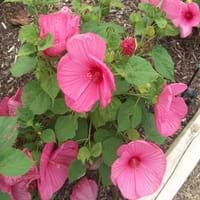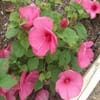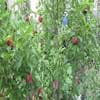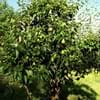Life Span
Annual and Perennial
Perennial
Type
Broadleaf Evergreen
Perennial
Origin
Not Available
Northeastern United States, Mid-Atlantic United States, Southeastern United States, North-Central United States, Central United States, South-Central United States
Types
Hibiscus Luna Pink Swirl
Hibiscus Luna Red
Hibiscus Luna White
Apricot Delight, Copper canyon
Habitat
gardens, Grassland, Homesteads, Subtropical climates, tropical environments
Roadsides, sand dunes, Waste areas
USDA Hardiness Zone
9-15
5-8
AHS Heat Zone
Not Available
8-1
Sunset Zone
21,22
1a, 1b, 2a, 2b, 3a, 3b, 4, 5, 6, 7, 8, 9, 10, 11, 12, 13, 14, 15, 16, 17, 18, 19, 20, 21, 22, 23, 24
Habit
Oval or Rounded
Clump-Forming
Flower Color
Light Pink, Pink, White
Yellow
Flower Color Modifier
Bicolor
Bicolor
Fruit Color
Non Fruiting Plant, Peach, White, Yellow
Tan
Leaf Color in Spring
Dark Green
Green
Leaf Color in Summer
Dark Green
Green
Leaf Color in Fall
Dark Green
Green
Leaf Color in Winter
Dark Green
Light Green
Plant Season
Spring, Summer, Fall, Winter
Summer
Sunlight
Full Sun, Partial Sun
Full Sun, Partial Sun
Growth Rate
Medium
Medium
Type of Soil
Loam
Loam, Sand
The pH of Soil
Neutral
Acidic, Neutral, Alkaline
Soil Drainage
Well drained
Well drained
Bloom Time
Early Summer, Summer, Late Summer, Early Fall, Fall, Indeterminate
Early Summer, Summer, Late Summer
Tolerances
Drought, Variety of soil types
Variety of soil types
Where to Plant?
Ground, Pot
Container, Ground, Pot
How to Plant?
Stem Cutting, Tip cutting, Vegetative Reproduction
Divison, Seedlings, Stem Planting
Plant Maintenance
Medium
Low
Watering Requirements
It cannot sustain wet-feet, Keep the Soil well drained, Requires watering in the growing season, Water Deeply, Water frequently while growing, Water more in summer, Water when soil is dry
Average Water Needs, Do Not over Water, Never Over-water, Requires regular watering, Water more in summer
In Summer
Lots of watering
Lots of watering
In Spring
Moderate
Moderate
In Winter
Average Water
Average Water
Soil pH
Neutral
Acidic, Neutral, Alkaline
Soil Type
Loam
Loam, Sand
Soil Drainage Capacity
Well drained
Well drained
Sun Exposure
Full Sun, Partial Sun
Full Sun, Partial Sun
Pruning
A hard prune may be necessary if the plant becomes woody, Cut leaves after fall, Cut or pinch the stems, Pinch or prune as they grow to promote branching and bushiness, Prune for shortening long shoots, Prune in early summer, Remove deadheads
Remove damaged leaves, Remove dead branches, Remove dead leaves, Remove dead or diseased plant parts
Fertilizers
Apply 10-10-10 amount, Balanced liquid fertilizer, Do not fertilize new plants until at least a month, Use a low phosphate fertilizer to improve the quality of the blooms
All-Purpose Liquid Fertilizer, fertilize in growing season
Pests and Diseases
Aphids, Mealybugs, Red spider mite, Scale, Thripes, Whiteflies
Slugs, Snails
Plant Tolerance
Drought, Variety of soil types
Variety of soil types
Flower Petal Number
Single
Single
Foliage Texture
Medium
Fine
Foliage Sheen
Glossy
Matte
Attracts
Bees, Butterflies, Hummingbirds
Insects
Allergy
no allergic reactions
Abdominal pain, Constipation, Diarrhea, Skin irritation
Aesthetic Uses
Beautification, Borders, Landscape Designing
Beautification, Borders, Landscape Designing, Showy Purposes
Beauty Benefits
Hair Conditioner, Not Available, Prevents greying of hair, Prevents Premature Baldness, Promotes Healthy Hair, Promotes healthy skin, Speed hair growth
Good for skin, Making cosmetics, Stops hair loss
Environmental Uses
Air purification
Air purification, Food for insects, Versatility
Medicinal Uses
anti-inflammatory, Diuretic, Hair Loss, High blood pressure, Vitamin C
Eczema
Part of Plant Used
Flowers, Leaf Stalks, Leaves
Root
Other Uses
Culinary use, Employed in herbal medicine, Jam, Jelly, Making Shampoo, Oil is used for aromatherapy, Oil is used in perfume, soaps, creams, etc., Showy Purposes, Traditional medicine, Use in Chinese herbology, Used As Food, Used as Ornamental plant, Used for bedding in gardens, Used for fragrance, Used for its medicinal properties, Used in making beverages, Used in paper industry, Used in salads, Used to make hair tonic
Decoration Purposes, Medicinal oil, Showy Purposes, Used as Ornamental plant, Used for its medicinal properties
Used As Indoor Plant
No
Yes
Used As Outdoor Plant
Yes
Yes
Garden Design
Container, Foundation, Houseplant, Mixed Border, Tropical
Edging, Feature Plant, Groundcover, Mixed Border
Botanical Name
Hibiscus moscheutos
OENOTHERA 'Cold Crick'
Common Name
Luna Rose, Common Rose Mallow, Common Swamp Mallow
Suncups, sundrops
In Hindi
हिबिस्कुस लूना गुलाब
Evening Primrose
In German
Hibiscus Luna Rose
Evening Primrose
In French
Hibiscus Luna Rose
onagre
In Spanish
Hibiscus Luna Rose
onagra
In Greek
Hibiscus Luna Rose
Νυχτολούλουδο
In Portuguese
Hibiscus Luna Rose
Evening Primrose
In Polish
Hibiscus Luna Rose
wiesiołka
In Latin
Hibiscus rosa Luna
vespere Primrose
Phylum
Magnoliophyta
Magnoliophyta
Class
Magnoliopsida
Magnoliopsida
Family
Malvaceae
Onagraceae
Clade
Angiosperms, Eudicots, Rosids
Angiosperms, Eudicots, Rosids
Subfamily
Malvoideae
Onagroideae
Season and Care of Hibiscus Luna Rose and Evening Primrose
Season and care of Hibiscus Luna Rose and Evening Primrose is important to know. While considering everything about Hibiscus Luna Rose and Evening Primrose Care, growing season is an essential factor. Hibiscus Luna Rose season is Spring, Summer, Fall and Winter and Evening Primrose season is Spring, Summer, Fall and Winter. The type of soil for Hibiscus Luna Rose is Loam and for Evening Primrose is Loam, Sand while the PH of soil for Hibiscus Luna Rose is Neutral and for Evening Primrose is Acidic, Neutral, Alkaline.
Hibiscus Luna Rose and Evening Primrose Physical Information
Hibiscus Luna Rose and Evening Primrose physical information is very important for comparison. Hibiscus Luna Rose height is 600.00 cm and width 60.00 cm whereas Evening Primrose height is 1.00 cm and width 0.10 cm. The color specification of Hibiscus Luna Rose and Evening Primrose are as follows:
Hibiscus Luna Rose flower color: Light Pink, Pink and White
Hibiscus Luna Rose leaf color: Dark Green
Evening Primrose flower color: Yellow
- Evening Primrose leaf color: Green
Care of Hibiscus Luna Rose and Evening Primrose
Care of Hibiscus Luna Rose and Evening Primrose include pruning, fertilizers, watering etc. Hibiscus Luna Rose pruning is done A hard prune may be necessary if the plant becomes woody, Cut leaves after fall, Cut or pinch the stems, Pinch or prune as they grow to promote branching and bushiness, Prune for shortening long shoots, Prune in early summer and Remove deadheads and Evening Primrose pruning is done Remove damaged leaves, Remove dead branches, Remove dead leaves and Remove dead or diseased plant parts. In summer Hibiscus Luna Rose needs Lots of watering and in winter, it needs Average Water. Whereas, in summer Evening Primrose needs Lots of watering and in winter, it needs Average Water.





